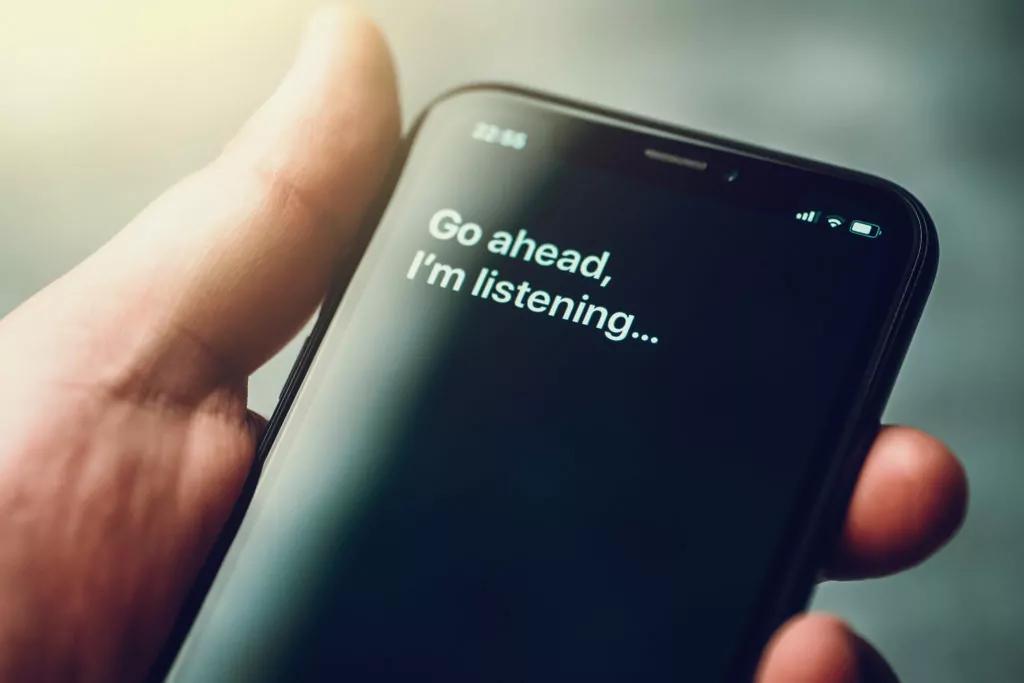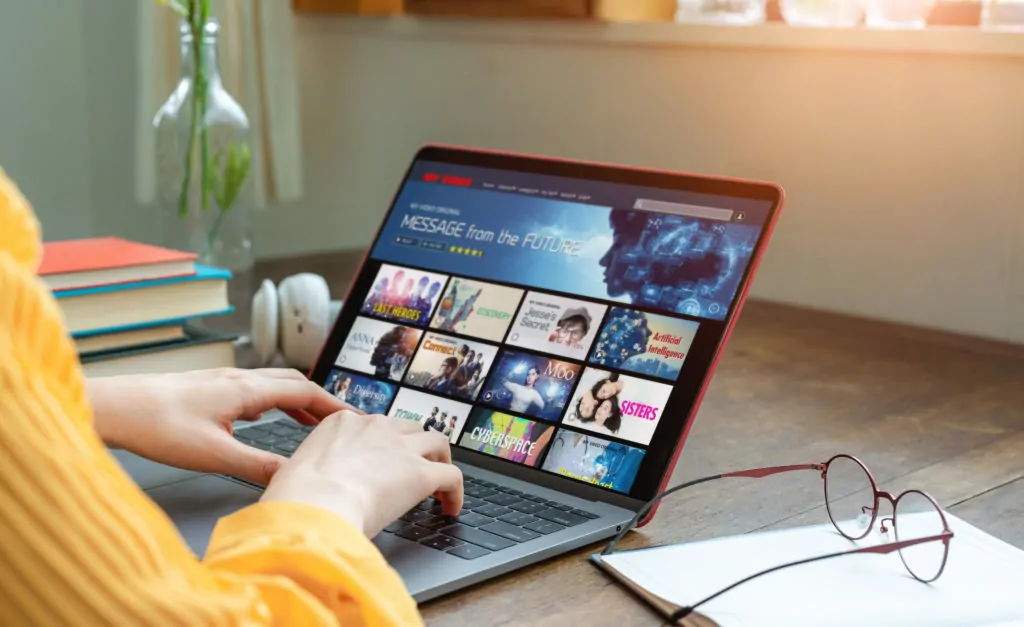Here’s how ads know what you’re thinking:
Ads can be so well targeted to you that it feels like they are reading your mind in real-time.
It’s not an accident, and it all works by collecting very large amounts of data and running it through sophisticated statistical functions and algorithms.
The ads know what you’re thinking because you are closely watched.
So if you want to learn all about ads knowing what you think, and so-called ad tracking, then this article is for you.
Let’s jump right in!
- Uber Algorithm: How Does It Work?
- DoorDash Algorithm: How Does It Work?
- OnlyFans Percentages: How Do They Work?
- Uber Eats Algorithm: How Does It Work?
- 7 Ways to Fix Your Hinge Algorithm
- Tinder: Likes & Matches at First, Then Stops?
- Snapchat Friend Suggestions: How Does It Work?

How Does Data Tracking Work For Ad Tracking? (8 Things)

Ok. So the ads know what you’re thinking because big tech companies track everything you do, and then through some mathemagic, they can figure you out.
That’s creepy, but assuming it’s true, how do they even get the data in the first place?
Sure, attaching your name to an account is easy, but these ads go way beyond that.
What’s involved in the process?
#1 Search History

Your search history is typically the most valuable source of data for anyone who wants to sell you something.
Now, not all data tracking is about sales, and we’ll get into that, but when it comes to targeted ads, your search history is a treasure trove.
The general idea is that you search for things you want to know more about before you make a purchase.
It doesn’t mean that every search you make is full of your shopping habits, but your buying trends can be revealed when someone takes a long hard look at your search history.
So, any app you use to browse the internet can track the browsing that you do on that app.
Depending on the user agreement, that information can be saved and even sold.
Here’s where it might feel a little creepier.
Search history tracking is not limited to web browsers.
Your phone, in general, can track your browsing history.
So can any app on the phone.
Facebook, Instagram, TikTok, and everything else you use is capable of going through your search history, and they will use that information to target you with ads.
If you look up how hard it is to climb Mt. Everest because you’re curious, there’s a chance that you will see ads for hiking and climbing gear.
They know what you’re thinking because they watch what you search for.
This is not limited to searches within a respective app.
TikTok is capable of seeing what you search for on your internet browsers.
Depending on settings and app agreements, it can see your activity on other apps as well.
Many other apps have these same capabilities.
If you want to fully understand what an app can see on your phone, read the whole user agreement.
It’s a long, challenging read, but you will likely see things in there that surprise you.
#2 App Time

App time is harder to parse, but it’s still useful.
You have apps on your devices, and you use those apps.
Your device, and the apps, keep track of how much time you spend on each app.
This doesn’t give nearly as much information about what is on your mind, but it is still revealing.
In particular, app time is used to figure out what style of advertising will be most effective when you see it.
Do you like detailed videos?
Simple images?
Memes?
There are a lot of ways for a company to hit you with an ad, and they fashion their advertising techniques based on the content that you tend to enjoy the most.
That is all based simply on how much you use each app you have installed.
#3 Microphone

The microphone is one of the things that leads to some of the deepest “mind-reading” when it comes to advertising.
Your phone (and other devices) has a microphone.
That microphone can record your voice, and those recordings can be sent over the internet.
That’s, more or less, how phone calls work, so you know the technology is there.
What you may or may not know is that your phone is designed to listen to anything it can recognize as a voice.
This is how voice activation works, and if your phone has permission to listen to you, it will.
If you want to be able to yell at Alexa to turn the lights on, the technology has to be able to passively listen for voice commands.
While listening, it will also take note of what you say, and your conversations will be churned through a whole bunch of algorithms to target you with ads.
Consider the following example. You and a friend have a conversation.
For some reason, they bring up childhood memories of rollerblading.
You don’t do any internet searches about it.
You don’t mention it on any social media.
The conversation doesn’t even last very long, but it is said out loud.
Then, you get an ad for rollerblades.
This is entirely because your microphone was listening, and that conversation was used to send ads your way.
It really does happen.
Real-world instances of microphone-based advertising are potentially a lot more sophisticated.
Not everything you say will result in a specific ad.
If you only mention rollerblading once, you’re less likely to see an ad for that as compared to things you discuss a lot more.
But, the overall trend of your conversations likely influences the ads that you see.
#4 Location Services

Another source of creepy ads is the location tracking that exists on your phone.
Your phone is capable of using GPS signaling to keep track of where you are.
It can also triangulate your location through cell tower pings, and it can figure out where you are based on what Wi-Fi you’re currently connected to.
Those features are used a lot, especially for navigation apps.
You’ve probably had your browser ask if it can keep track of where you are too.
It will use this to filter search results based on your location, so if you look up, say, pizza restaurants, it will prioritize the ones closest to you.
Every app on your phone is theoretically capable of using location services.
Not all apps are designed to take advantage of this feature, but that is up to the discretion of the app developer.
Some apps might surprise you with their use of location services, like your Wallet app or Netflix.
If you don’t specifically deny them permission, apps that use location services will cater information based on where you are, and the ads you receive will reflect that.
But this actually runs a lot deeper. These location services are more precise than you might imagine.
They don’t just know your current address.
They can tell where you are in your own home.
They can even track how often you go to the bathroom.
Location services tracking is so precise that app data can be used to figure out your eating habits and then use that data to target you with food ads.
#5 Purchasing

This one will probably come as less of a surprise and make more sense.
Your purchase history is tracked, and that information is used to send you future advertisements.
You have probably experienced this when it doesn’t work.
Amazon is notorious for sending special offers to customers to buy additional products in a similar vein to what they had before.
So, when a homeowner has to replace a toilet, amazon might send them deals and coupons for more toilets, toilet seats, and things of this nature.
Obviously, that purchase was out of necessity, and these extra ads aren’t working.
But other times, your purchase history says a lot about you.
If you buy a sandwich from the shop around the corner every Thursday on your lunch break, then the tracking is easy.
You like sandwiches, and some coupons can target that.
But what if you start buying a new multivitamin out of the blue?
What does that say about your behavior?
Or, what if you switch lotions?
Alone, each of these purchase decisions means little but put through big data and statistics.
They can actually say a ton.
Companies can figure out major events in your life based solely on your purchase history.
In fact, these specific purchases were used to figure out when women were pregnant, and the algorithm was surprisingly accurate.
When combined with other data tracking, things get eerie pretty fast.
#6 Subscriptions

Technically, subscriptions are purchases, but they are tracked with extra vigor.
The idea is that a subscription is the most valuable type of purchase because you make it over and over again.
This can include gym memberships, wine clubs, Netflix, and anything else that has a recurring billing cycle.
Subscriptions tell advertisers what you care about the most, and you can trust that your subscription choices will influence the ads you see more than almost any other part of your daily life and regular routine.
#7 Interactions on Apps

If companies can track your browsing history, can they also track what you do on your different apps?
Yes, and yes.
Every app you use logs carefully what you do with it.
Let’s use Instagram as an example.
Instagram knows exactly which accounts you have viewed and followed.
It knows which pictures you have liked, commented on, and just viewed.
It knows how long you spent looking at each picture, and it puts all of this data through a bunch of number crunching.
Using pattern recognition, Instagram probably knows things about you that you don’t even realize.
They know what kind of model will catch your attention for an ad.
They know what activities you prefer, what you find funny, and what you might be willing to purchase.
That’s just one example.
Every app is able to track your interactions this closely, and what’s more, is that they often share information.
The things you do on Instagram can be and are seen by Google, for instance.
How this information is shared can get complicated, and we’ll get into it a little later.
#8 Personal Information

This one surprises a lot of people until they stop to really think about it.
The different apps and services that you use typically ask for some personal information to get started.
If money is involved, they need your name and billing address, but even free apps ask for at least that much.
Then, they take you through a questionnaire that is designed to help them curate content that you will like.
They ask you about hobbies, interests, education, family life, and so much more.
That information really does help them curate content.
It also helps them curate ads.
How does Facebook know that you started a kayaking club in college several years back?
You told them, and then you forgot that you put that information into a survey at one point.
How Do Companies Buy Data For Ad Tracking? (2 Things)

You’ve probably heard that your personal data gets sold.
Is that really true?
Yes.
So, how do companies get data from each other?
Is there a big data market where they set up booths and sell info to each other?
Is it all hush-hush and on some kind of black or gray market?
Well, it’s really a mix of things.
#1 Expanding the Database

Any company is ultimately limited in how it can collect data.
Your phone can collect a lot of stuff, but privacy agreements prevent phone companies from looking at everything.
Similarly, Facebook can keep track of what you do on their site, but they have a harder time seeing what you do on TikTok (although these aren’t perfect limitations).
To compensate, companies sell each other data.
This does two things.
First, it helps them make more money.
These free social media apps aren’t funded entirely by the ads you never click.
They also pad their pockets by selling data they collected from you.
Second, selling data among big companies allows each to build a more complete database.
With enough information, statistical analytics become amazingly powerful and more valuable.
These companies are always looking for more data.
#2 Data Brokers

When it comes to how companies sell data to each other, a lot of it is done through the use of third-party brokers.
There are a few reasons for this.
For starters, the market is big enough that brokerage specialists are actually worth a lot to big companies.
This happens in any market.
If there are enough buyers, people will figure out how to be the best sellers.
Another reason for data brokers is that they can get around some regulations and red tape that might otherwise make data acquisition difficult.
Data brokerages can register in countries with less regulation.
They can collect more data than many other companies (mostly by buying it), and they are less restricted in how they sell that data.
That said, direct data sales still happen between companies too. Data brokers manage to fill the gaps nicely.
How Do They Use the Data For Ad Tracking? (4 Things)

You know how the data is collected.
You know how it is shared.
How does it get from being a bunch of raw data to allowing them to see inside of your headspace?
How are the ads so eerily accurate so many times?
That all stems from how the data is processed and why all of this is done.
Here’s a hint, it has to do with more than just advertising.
#1 Lots of AI

Most of this comes down to artificial intelligence (AI) and very powerful statistics.
Google is commonly renowned as the best AI company in the business.
All Google searches are built on their AI, and it has succeeded many of us on many occasions.
But perfect search algorithms are only a small portion of what Google is trying to do with its artificial intelligence.
One purpose of using their search engine to refine AI is to make them better at advertising.
The same code that helps you find what you’re really searching for on the internet helps other companies find who they’re really looking for with ads.
Sometimes, it can feel like they are literally reading your mind.
It’s entirely because the AI is just that good at taking personal data and extrapolating additional likes, interests, and things that you might want to buy.
#2 Timed Ads

When all of this works at the pinnacle of its intent, the advertisements are timed for you to see them when they are most likely to elicit a response.
Sometimes, that means hitting you with ads when you look up something new (like new socks).
They know that you’re searching for socks, so they advertise a bunch to you while you’re probably still in the market.
Other times, they will send ads to you on an anniversary or birthday.
Obviously. Seasonal ads are a thing.
If you reveal a favorite sport, they’ll advertise around it nearer the championships.
You get the idea.
Well-timed ads get the most purchases, so they want to “read your mind” in order to get you at the best time to complete a sale.
That’s what it’s all about.
#3 Content

Here’s the craziest part of all of this.
The most valuable ads are ones that you will end up wanting to share.
Companies don’t have to pay per click when you’re doing the advertising for them.
This is high-level advertising, and it’s based on your user data more than anything else.
If you regularly interact with certain types of content, you will be sent ads that are built on that content style.
You’ll get ads in the same format as your favorite video, and it will appeal to your sense of humor and interests.
You’ll like it enough to then share that ad with other people.
Do you have doubts?
Have you ever shared a trailer for a movie?
That’s exactly what is happening. You shared the ad, so they didn’t have to pay for it.
In fact, the movie industry makes money off of its online video trailers.
Content-based advertising is that intense.
#4 Research and Development

The last major topic we need to cover is research and development, and there are two sides to this coin.
Big data is used to better understand what customers actually want.
This steers business models and even the development of products and services.
If enough people mention that they would like a specific app, Google (or any other company) can pick up on that and invest in the app’s development.
The other half of this is to expand their own experiments.
All of this stuff runs on AI and emerging technologies.
The big-data space is used to refine those technologies for more improvements in the next iteration.
It creates a weird kind of circle.
They develop the technology to collect data, and they collect data to improve the technology.
But all of it is funded because they are able to send you ads that are so accurate to your daily life that it feels like they read your mind.

